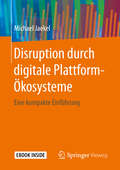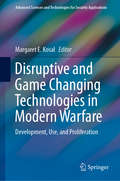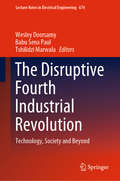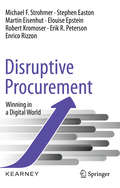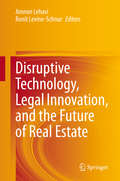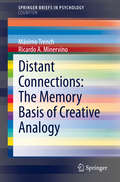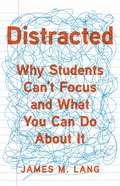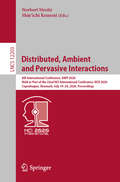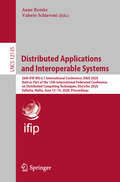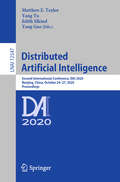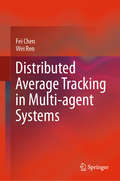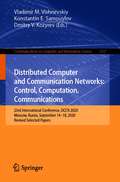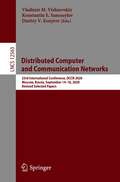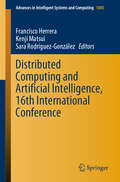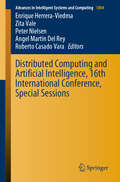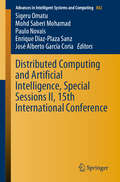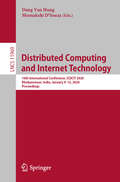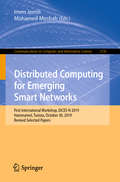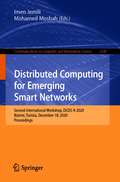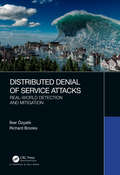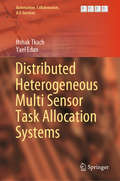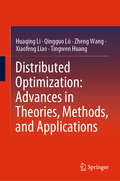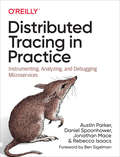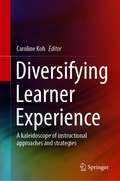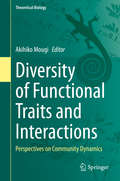- Table View
- List View
Disruption durch digitale Plattform-Ökosysteme: Eine kompakte Einführung
by Michael JaekelDisruption ist das Schlagwort einer Digitalmoderne, in der digitale Plattform-Ökosysteme eine neue Ökonomie erzeugen. Es expandiert eine Plattform-Ökonomie, die etablierte Unternehmen und Industrien in ihren Grundfesten erschüttert. Die Erschütterungen werden von dem Phänomen der Disruption ausgelöst. In Literatur und Praxis wird der Begriff der Disruption aber inflationär für nahezu alles herangezogen. Daher zielt das vorliegende kompakte Buch auf die kohärente Klärung des Begriffs der Disruption als ein Axiom der Digitalmoderne ab. Zudem erläutert der Autor die Expansionsdynamiken digitaler Plattform-Öko-Systeme durch Big Data-Management und Anwendungen der schwachen Künstlichen Intelligenz. Die Ausführungen zeigen die Relevanz der Disruptionstheorie praxisorientiert am Beispiel der digitalen Transformation eines großen Verlagshauses. Der Autor bietet mit seinem Werk Denkwerkzeuge und -anregungen, jedoch keinen schablonenhaften Ratgeber. Damit richtet sich das Buch an alle, die sich mit disruptiven Dynamiken der Digitalisierung kritisch auseinandersetzen und eigene Gedanken weiterentwickeln möchten.
Disruptive and Game Changing Technologies in Modern Warfare: Development, Use, and Proliferation (Advanced Sciences and Technologies for Security Applications)
by Margaret E. KosalThis book explores and analyzes emerging innovations within today’s most cutting-edge science and technology (S&T) areas, which are cited as carrying the potential to revolutionize governmental structures, economies, and international security. Some have argued that such technologies will yield doomsday scenarios and that military applications of such technologies have even greater potential than nuclear weapons to radically change the balance of power. As the United States looks to the future – whether dominated by extremist groups co-opting advanced weapons in the world of globalized non-state actors or states engaged in persistent regional conflicts in areas of strategic interest – new adversaries and new science and technology will emerge. Choices made today that affect science and technology will impact how ably the US can and will respond. Chapters within the book look at the changing strategic environment in which security operations are planned and conducted; how these impact science and technology policy choices made today; and predictions of how science and technology may play a beneficial or deleterious role in the future. Some game changing technologies have received global attention, while others may be less well known; the new technologies discussed within this proposal, as well as future discoveries, may significantly alter military capabilities and may generate new threats against military and civilian sectors.
The Disruptive Fourth Industrial Revolution: Technology, Society and Beyond (Lecture Notes in Electrical Engineering #674)
by Wesley Doorsamy Babu Sena Paul Tshilidzi MarwalaThe book explores technological advances in the fourth industrial revolution (4IR), which is based on a variety of technologies such as artificial intelligence, Internet of Things, machine learning, big data, additive printing, cloud computing, and virtual and augmented reality. Critically analyzing the impacts and effects of these disruptive technologies on various areas, including economics, society, business, government, labor, law, and environment, the book also provides a broad overview of 4IR, with a focus on technologies, to allow readers to gain a deeper understanding of the recent advances and future trajectories. It is intended for researchers, practitioners, policy-makers and industry leaders.
Disruptive Procurement: Winning in a Digital World
by Michael F. Strohmer Stephen Easton Martin Eisenhut Elouise Epstein Robert Kromoser Erik R. Peterson Enrico RizzonDisruptive Procurement is a radical new approach to creating value and innovation by challenging the status quo in the entire product and service line. It requires going far beyond conventional desktop procurement to understand the value the company brings to its customers as well as the value that suppliers bring to the company. By combining knowledge of these two dimensions, companies become far more flexible and they move closer to disrupting the environment in ways that create value. To move toward Disruptive Procurement, companies need a holistic view and a complete new set of capabilities for staff in marketing, sales, R&D, manufacturing, innovation, and, of course, procurement. This will only happen if procurement is fully backed by the Chief Executive Officer and companies embrace digital tools that will help make procurement slimmer and smarter.
Disruptive Technology, Legal Innovation, and the Future of Real Estate
by Amnon Lehavi Ronit Levine-SchnurThis book addresses challenges that new technologies and the big data revolution pose to existing regulatory and legal frameworks. The volume discusses issues such as blockchain and its implications for property transactions and taxes, three (or four) dimensional title registration, land use and urban planning in the age of big data, and the future of property rights in light of these changes. The book brings together an interdisciplinary collection of chapters that revolve around the potential influence of disruptive technologies on existing legal norms and the future development of real estate markets. The book is divided into five parts. Part I presents a survey of the current available research on blockchain and real estate. Part II provides a background on property law for the volume, grounding it in fundamental theory. Part III discusses the changing landscapes of property rights while Part IV debates the potential effects of blockchain on land registration. Finally the book concludes with Part V, which is devoted to new technological applications relevant to real estate. Providing an interdisciplinary perspective on emerging technologies that have the potential to disrupt the real estate industry and the regulation of it, this book will appeal to a broad audience, consisting of scholars, policy-makers, practitioners, and students, interested in real estate, law, economics, blockchain, and technology policy.
Distant Connections: The Memory Basis of Creative Analogy (SpringerBriefs in Psychology)
by Máximo Trench Ricardo A. MinervinoAnalogical thinking lies at the core of human cognition, pervading from the most mundane to the most extraordinary forms of creativity. By connecting poorly understood phenomena to learned situations whose structure is well articulated, it allows reasoners to expand the boundaries of their knowledge. The first part of the book begins by fleshing out the debate around whether our cognitive system is well-suited for creative analogizing, and ends by reviewing a series of studies that were designed to decide between the experimental and the naturalistic accounts. The studies confirm the psychological reality of the surface bias revealed by most experimental studies, thus claiming for realistic solutions to the problem of inert knowledge. The second part of the book delves into cognitive interventions, while maintaining an emphasis on the interplay between psychological modeling and instructional applications. It begins by reviewing the first generation of instructional interventions aimed at improving the later retrievability of educational contents by highlighting their abstract structure. Subsequent chapters discuss the most realistic avenues for devising easily-executable and widely-applicable ways of enhancing access to stored knowledge that would otherwise remain inert. The authors review results from studies from both others and their own lab that speak of the promise of these approaches.
Distracted: Why Students Can't Focus and What You Can Do About It
by James M. LangKeeping students focused can be difficult in a world filled with distractions -- which is why a renowned educator created a scientific solution to one of every teacher's biggest problems.Why is it so hard to get students to pay attention? Conventional wisdom blames iPhones, insisting that access to technology has ruined students' ability to focus. The logical response is to ban electronics in class. But acclaimed educator James M. Lang argues that this solution obscures a deeper problem: how we teach is often at odds with how students learn. Classrooms are designed to force students into long periods of intense focus, but emerging science reveals that the brain is wired for distraction. We learn best when able to actively seek and synthesize new information. In Distracted, Lang rethinks the practice of teaching, revealing how educators can structure their classrooms less as distraction-free zones and more as environments where they can actively cultivate their students' attention. Brimming with ideas and grounded in new research, Distracted offers an innovative plan for the most important lesson of all: how to learn.
Distributed, Ambient and Pervasive Interactions: 8th International Conference, DAPI 2020, Held as Part of the 22nd HCI International Conference, HCII 2020, Copenhagen, Denmark, July 19–24, 2020, Proceedings (Lecture Notes in Computer Science #12203)
by Norbert Streitz Shin’ichi KonomiThis conference proceeding LNCS 12203 constitutes the refereed proceedings of the 12th International Conference on Cross-Cultural Design, CCD 2020, held as part of HCI International 2020 in Copenhagen, Denmark in July 2020.The conference was held virtually due to the corona pandemic. The total of 1439 papers and 238 posters included in the 40 HCII 2020 proceedings volumes was carefully reviewed and selected from 6326 submissions. The regular papers of DAPI 2020, Distributed, Ambient and Pervasive Interactions, presented in this volume were organized in topical sections named: Design Approaches, Methods and Tools, Smart Cities and Landscapes, Well-being, Learning and Culture in Intelligent Environments and much more.
Distributed Applications and Interoperable Systems: 20th IFIP WG 6.1 International Conference, DAIS 2020, Held as Part of the 15th International Federated Conference on Distributed Computing Techniques, DisCoTec 2020, Valletta, Malta, June 15–19, 2020, Proceedings (Lecture Notes in Computer Science #12135)
by Anne Remke Valerio SchiavoniThis book constitutes the proceedings of the 20th IFIP International Conference on Distributed Applications and Interoperable Systems, DAIS 2020, which was supposed to be held in Valletta, Malta, in June 2020, as part of the 15th International Federated Conference on Distributed Computing Techniques, DisCoTec 2020. The conference was held virtually due to the COVID-19 pandemic. The 10 full papers presented together with 1 short paper and 1 invited paper were carefully reviewed and selected from 17 submissions. The papers addressed challenges in multiple application areas, such as privacy and security, cloud and systems, fault-tolerance and reproducibility, machine learning for systems, and distributed algorithms.
Distributed Artificial Intelligence: Second International Conference, DAI 2020, Nanjing, China, October 24–27, 2020, Proceedings (Lecture Notes in Computer Science #12547)
by Matthew E. Taylor Yang Yu Edith Elkind Yang GaoThis book constitutes the refereed proceedings of the Second International Conference on Distributed Artificial Intelligence, DAI 2020, held in Nanjing, China, in October 2020. The 9 full papers presented in this book were carefully reviewed and selected from 22 submissions. DAI aims at bringing together international researchers and practitioners in related areas including general AI, multiagent systems, distributed learning, computational game theory, etc., to provide a single, high-profile, internationally renowned forum for research in the theory and practice of distributed AI. Due to the Corona pandemic this event was held virtually.
Distributed Average Tracking in Multi-agent Systems
by Fei Chen Wei RenThis book presents a systematic study of an emerging field in the development of multi-agent systems. In a wide spectrum of applications, it is now common to see that multiple agents work cooperatively to accomplish a complex task. The book assists the implementation of such applications by promoting the ability of multi-agent systems to track — using local communication only — the mean value of signals of interest, even when these change rapidly with time and when no individual agent has direct access to the average signal across the whole team; for example, when a better estimation/control performance of multi-robot systems has to be guaranteed, it is desirable for each robot to compute or track the averaged changing measurements of all the robots at any time by communicating with only local neighboring robots. The book covers three factors in successful distributed average tracking: algorithm design via nonsmooth and extended PI control;distributed average tracking for double-integrator, general-linear, Euler–Lagrange, and input-saturated dynamics; andapplications in dynamic region-following formation control and distributed convex optimization. The book presents both the theory and applications in a general but self-contained manner, making it easy to follow for newcomers to the topic. The content presented fosters research advances in distributed average tracking and inspires future research directions in the field in academia and industry.
Distributed Computer and Communication Networks: 23rd International Conference, DCCN 2020, Moscow, Russia, September 14-18, 2020, Revised Selected Papers (Communications in Computer and Information Science #1337)
by Vladimir M. Vishnevskiy Konstantin E. Samouylov Dmitry V. KozyrevThis book constitutes the refereed proceedings of the 23rd International Conference on Distributed and Computer and Communication Networks, DCCN 2020, held in Moscow, Russia, in September 2020. Due to the COVID-19 pandemic the conference was held online. The 43 papers were carefully reviewed and selected from 167 submissions.The papers are organized in the following topical sections: computer and communication networks and technologies; analytical modeling of distributed systems, and distributed systems applications.
Distributed Computer and Communication Networks: 23rd International Conference, DCCN 2020, Moscow, Russia, September 14–18, 2020, Revised Selected Papers (Lecture Notes in Computer Science #12563)
by Vladimir M. Vishnevskiy Konstantin E. Samouylov Dmitry V. KozyrevThis book constitutes the refereed post-conference proceedings of the 23rd International Conference on Distributed and Computer and Communication Networks, DCCN 2020, held in Moscow, Russia, in September 2020.The 54 revised full papers and 1 revised short paper were carefully reviewed and selected from 167 submissions. The papers cover the following topics: computer and communication networks; analytical modeling of distributed systems; and distributed systems applications.
Distributed Computing and Artificial Intelligence, 16th International Conference (Advances in Intelligent Systems and Computing #1003)
by Francisco Herrera Kenji Matsui Sara Rodríguez-GonzálezThis book features the outcomes of the 16th International Conference on Distributed Computing and Artificial Intelligence 2019 (DCAI 2019), which is a forum to present applications of innovative techniques for studying and solving complex problems in artificial intelligence and computing. The exchange of ideas between scientists and technicians from both the academic and industrial sectors is essential to facilitate the development of systems that can meet the ever-increasing demands of today’s society. This book brings together lessons learned, current work and promising future trends associated with distributed computing, artificial intelligence and their application to provide efficient solutions to real-world problems.The book includes 29 high-quality and diverse contributions in established and emerging areas of research presented at the symposium organized by the Osaka Institute of Technology, Hiroshima University, University of Granada and University of Salamanca, which was held in Ávila, Spain, from 26th–28th June 2019
Distributed Computing and Artificial Intelligence, 16th International Conference, Special Sessions (Advances in Intelligent Systems and Computing #1004)
by Enrique Herrera-Viedma Zita Vale Peter Nielsen Angel Martin Del Rey Roberto Casado VaraThis book presents the outcomes of the special sessions of the 16th International Conference on Distributed Computing and Artificial Intelligence 2019, a forum that brought together ideas, projects and lessons associated with distributed computing and artificial intelligence, and their applications in various areas. Artificial intelligence is currently transforming our society. Its application in distributed environments, such as the internet, electronic commerce, environmental monitoring, mobile communications, wireless devices, and distributed computing, to name but a few, is continuously increasing, making it an element of high added value and tremendous potential. These technologies are changing constantly as a result of the extensive research and technical efforts being pursued at universities and businesses alike. The exchange of ideas between scientists and technicians from both the academic and industrial sectors is essential to facilitating the development of systems that can meet the ever-growing demands of today’s society. This year’s technical program was characterized by high quality and diversity, with contributions in both well-established and evolving areas of research. More than 120 papers were submitted to the main and special sessions tracks from over 20 different countries (Algeria, Angola, Austria, Brazil, Colombia, France, Germany, India, Italy, Japan, the Netherlands, Oman, Poland, Portugal, South Korea, Spain, Thailand, Tunisia, the United Kingdom and United States), representing a truly “wide area network” of research activity. The symposium was jointly organized by the Osaka Institute of Technology and the University of Salamanca. This year’s event was held in Avila, Spain, from 26th to 28th June, 2019. The authors wish to thank the sponsors: the IEEE Systems Man and Cybernetics Society, Spain Section Chapter and the IEEE Spain Section (Technical Co-Sponsor), IBM, Indra, Viewnext, Global Exchange, AEPIA, APPIA and AIR institute.
Distributed Computing and Artificial Intelligence, Special Sessions II, 15th International Conference (Advances in Intelligent Systems and Computing #802)
by Sigeru Omatu Mohd Saberi Mohamad Paulo Novais Enrique Díaz-Plaza Sanz José Alberto García CoriaThis book addresses a broad range of topics, from newly proposed techniques in Artificial Intelligence (AI) and Machine Learning to various applications such as decision-making, pattern classification for data, image and signals, robotics, and control systems. Big data applications are discussed, while improved methods and wholly new methods for using deep learning technologies are also presented. The topics covered are comprehensive and reflect a wide range of technologies in the area. In particular, the latest methods in deep learning approaches and applications are discussed in many parts of the book, providing a better understanding of these new technologies. The book’s general scope includes the latest methods in the areas of Artificial Intelligence and Machine Learning for use in distributed computing as well as decision support systems. As the book covers a rather wide area, its intended readership ranges from those working in AI and machine learning technologies to those working on applications utilizing these technologies, researchers new to these areas who need background information on the technologies and applications, and more experienced researchers looking for new methods and applications.
Distributed Computing and Internet Technology: 16th International Conference, ICDCIT 2020, Bhubaneswar, India, January 9–12, 2020, Proceedings (Lecture Notes in Computer Science #11969)
by Dang Van Hung Meenakshi D’SouzaThis book constitutes the proceedings of the 16th International Conference on Distributed Computing and Internet Technology, ICDCIT 2020, held in Bhubaneswar, India, in January 2020. The 20 full and 3 short papers presented in this volume were carefully reviewed and selected from 110 submissions. In addition, the book included 6 invited papers. The contributions were organized in topical sections named: invited talks; concurrent and distributed systems modelling and verification; cloud and grid computing; social networks, machine learning and mobile networks; data processing and blockchain technology; and short papers.
Distributed Computing for Emerging Smart Networks: First International Workshop, DiCES-N 2019, Hammamet, Tunisia, October 30, 2019, Revised Selected Papers (Communications in Computer and Information Science #1130)
by Mohamed Mosbah Imen JemiliThis book contains extended versions of the best papers presented at the First International Workshop on Distributed Computing for Emerging Smart Networks, DiCES-N 2019, held in Hammamet, Tunisia, in October 2019.The 9 revised full papers included in this volume were carefully reviewed and selected from 24 initial submissions. The papers are organized in the following topical sections: intelligent transportation systems; distributed computing for networking and communication; articial intelligence applied to cyber physical systems.
Distributed Computing for Emerging Smart Networks: Second International Workshop, DiCES-N 2020, Bizerte, Tunisia, December 18, 2020, Proceedings (Communications in Computer and Information Science #1348)
by Imen Jemili Mohamed MosbahThis book constitutes the refereed proceedings of the Second International Workshop on Distributed Computing for Emerging Smart Networks, DiCES-N 2020, held in Bizerte, Tunisia, in December 2020. Due to the COVID-19 pandemic the conference was held online. The 8 full papers included in this volume were carefully reviewed and selected from numerous submissions. The papers are organized in the following topical sections: intelligent transportation systems; emerging networking technologies; artificial intelligence and internet of things.
Distributed Denial of Service Attacks: Real-world Detection and Mitigation
by İlker Özçelik Richard BrooksDistributed Denial of Service (DDoS) attacks have become more destructive, wide-spread and harder to control over time. This book allows students to understand how these attacks are constructed, the security flaws they leverage, why they are effective, how they can be detected, and how they can be mitigated. Students use software defined networking (SDN) technology to created and execute controlled DDoS experiments. They learn how to deploy networks, analyze network performance, and create resilient systems. This book is used for graduate level computer engineering instruction at Clemson University. It augments the traditional graduate computing curricula by integrating: Internet deployment, network security, ethics, contemporary social issues, and engineering principles into a laboratory based course of instruction. Unique features of this book include: A history of DDoS attacks that includes attacker motivations Discussion of cyber-war, censorship, and Internet black-outs SDN based DDoS laboratory assignments Up-to-date review of current DDoS attack techniques and tools Review of the current laws that globally relate to DDoS Abuse of DNS, NTP, BGP and other parts of the global Internet infrastructure to attack networks Mathematics of Internet traffic measurement Game theory for DDoS resilience Construction of content distribution systems that absorb DDoS attacks This book assumes familiarity with computing, Internet design, appropriate background in mathematics, and some programming skills. It provides analysis and reference material for networking engineers and researchers. By increasing student knowledge in security, and networking; it adds breadth and depth to advanced computing curricula.
Distributed Heterogeneous Multi Sensor Task Allocation Systems (Automation, Collaboration, & E-Services #7)
by Itshak Tkach Yael EdanToday’s real-world problems and applications in sensory systems and target detection require efficient, comprehensive and fault-tolerant multi-sensor allocation. This book presents the theory and applications of novel methods developed for such sophisticated systems. It discusses the advances in multi-agent systems and AI along with collaborative control theory and tools. Further, it examines the formulation and development of an allocation framework for heterogeneous multi-sensor systems for various real-world problems that require sensors with different performances to allocate multiple tasks, with unknown a priori priorities that arrive at unknown locations at unknown time. It demonstrates how to decide which sensor to allocate to which tasks when and where. Lastly, it explains the reliability and availability issues of task allocation systems, and includes methods for their optimization.The presented methods are explained, measured, and evaluated by extensive simulations, and the results of these simulations are presented in this book. This book is an ideal resource for academics, researchers and graduate students as well as engineers and professionals and is relevant for various applications such as sensor network design, multi-agent systems, task allocation, target detection, and team formation.
Distributed Optimization: Advances in Theories, Methods, and Applications
by Huaqing Li Qingguo Lü Zheng Wang Xiaofeng Liao Tingwen HuangThis book offers a valuable reference guide for researchers in distributed optimization and for senior undergraduate and graduate students alike. Focusing on the natures and functions of agents, communication networks and algorithms in the context of distributed optimization for networked control systems, this book introduces readers to the background of distributed optimization; recent developments in distributed algorithms for various types of underlying communication networks; the implementation of computation-efficient and communication-efficient strategies in the execution of distributed algorithms; and the frameworks of convergence analysis and performance evaluation. On this basis, the book then thoroughly studies 1) distributed constrained optimization and the random sleep scheme, from an agent perspective; 2) asynchronous broadcast-based algorithms, event-triggered communication, quantized communication, unbalanced directed networks, and time-varying networks, from a communication network perspective; and 3) accelerated algorithms and stochastic gradient algorithms, from an algorithm perspective. Finally, the applications of distributed optimization in large-scale statistical learning, wireless sensor networks, and for optimal energy management in smart grids are discussed.
Distributed Tracing in Practice: Instrumenting, Analyzing, and Debugging Microservices
by Austin Parker Daniel Spoonhower Jonathan Mace Ben Sigelman Rebecca IsaacsMost applications today are distributed in some fashion. Monitoring the health and performance of these distributed architectures requires a new approach. Enter distributed tracing, a method of profiling and monitoring applications—especially those that use microservice architectures. There’s just one problem: distributed tracing can be hard. But it doesn’t have to be.With this practical guide, you’ll learn what distributed tracing is and how to use it to understand the performance and operation of your software. Key players at Lightstep walk you through instrumenting your code for tracing, collecting the data that your instrumentation produces, and turning it into useful, operational insights. If you want to start implementing distributed tracing, this book tells you what you need to know.You’ll learn:The pieces of a distributed tracing deployment: Instrumentation, data collection, and delivering valueBest practices for instrumentation (the methods for generating trace data from your service)How to deal with or avoid overhead, costs, and samplingHow to work with spans (the building blocks of request-based distributed traces) and choose span characteristics that lead to valuable tracesWhere distributed tracing is headed in the future
Diversifying Learner Experience: A kaleidoscope of instructional approaches and strategies
by Caroline KohThis book brings together strategies and innovations that educators from diverse educational contexts have conceptualized and implemented to cater to differences in academic ability, as well as in other domains such as psychosocial contexts and developmental needs. The emergence of IT and new technologies have altered the educational landscape and opened a multitude of opportunities for diverse modes of instruction catering to diverse student populations.The book addresses the gap in the literature with evidence-based reports of innovative strategies and approaches that are grounded in educational research. It identifies student differences in terms of academic ability and also, with regard to their cultural and social background, their developmental and psycho-emotional needs. It examines how new technologies are used in instructional approaches and how these innovative strategies diversify learner experiences. The book is a valuable resource to practitioners, researchers and educational administrators.
Diversity of Functional Traits and Interactions: Perspectives on Community Dynamics (Theoretical Biology)
by Akihiko MougiThis book presents new theoretical perspectives on ecological community dynamics and in so doing casts fresh light on the enduring complexity–stability debate. Real ecological communities do not simply comprise diverse species and interactions, which respectively represented the nodes and links of the classic network theory. Rather, they are characterized by different types of complexity, and this book explains how this diversity of complexity is key to understanding the dynamics of ecological communities. It is shown how various properties in natural communities, such as life history, adaptation, density dependence, sex, interaction types, space, functional traits, and microbial processes, can dramatically increase the complexity in ecological communities. Furthermore, innovative methods are introduced that may be applied to cast light on very complex communities. With each chapter presenting the latest advances and approaches, the book sets the direction for future research on ecological community dynamics. It will be a “must read” for researchers and students in the field of ecology.
